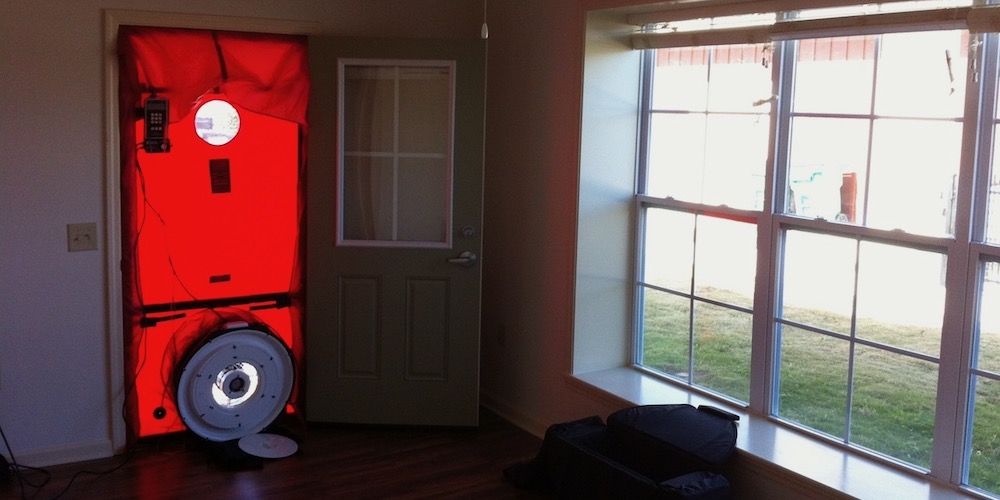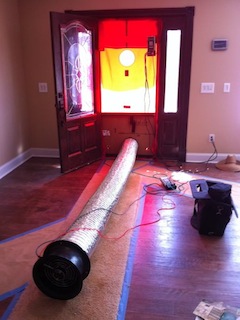Size Matters — How Big a House Can You Test with One Blower Door?

I get asked variations of this question often enough that it’s worth addressing here. If you’re doing a blower door test, how big a house can you test with one fan? Or, put another way, how many blower doors do you need to test a really large house? That question has no answer because it’s based on a faulty premise.
Does size matter?
Yes, it does. But it’s not the size of the house that matters. It’s the size of the hole in the house. You could have difficulty pressurizing a 3000 square foot house to 50 Pascals (Pa) with a blower door. Alternatively, as HERS rater Eric Griffin learned yesterday in the PHIUS+ Rater Training at the RESNET conference in Orlando, you might be able to get a 40,000 square foot house to 50 Pa using the much smaller Duct Blaster fan.
There are two problems with asking how big a house you can test with one blower door fan:
- The amount of leakage scales with the area of the building enclosure, not the conditioned floor area (and certainly not with the volume).
- Every home has a different amount of leakage per square foot of building enclosure.
If, on the contrary, leakage increased with the amount of conditioned floor area and every home had the same amount of leakage per square foot of floor area, then the question would be valid. They aren’t, however, so it isn’t.
What’s the flow rate?
If a 3000 square foot home has an infiltration rate of 10,000 cfm when the pressure difference across the house is 50 Pa, one blower door fan will not get the house to 50 Pa. The Minneapolis blower door can get up to about 5,300 cfm at 50 Pa (cfm50). The Retrotec Q46 can go up to about 5,600 cfm50, so you’d need about two of either type. (You can still get a cfm50 even without getting a 50 Pa pressure difference, though, because of the cool mathematical property known as extrapolation.)
 The 40,000 square foot house that could be tested with a Minneapolis Duct Blaster fan, however, must have had an infiltration rate of only 1,000 cfm50 or so, the limit of what those fans can do.
The 40,000 square foot house that could be tested with a Minneapolis Duct Blaster fan, however, must have had an infiltration rate of only 1,000 cfm50 or so, the limit of what those fans can do.
The cfm50 doesn’t tell you if the home is leaky anymore than my telling you I have a 230 pound friend tells you if he’s fat. 1,000 cfm50 could be really leaky if we’re talking about a really small house, or it could be amazingly tight in the case of the 40,000 square foot house. That’s where air changes per hour (ACH50) and cfm per square foot of building enclosure area come in. By normalizing to the size of the house, you can decide if it’s leaky just as if I tell you that my 230 pound friend is 6’6″ tells you he’s not fat.
Speaking of testing homes with duct tester fans, I did that last year in a net zero home near Memphis, Tennessee.
Upshot
A really small house might be really leaky and need more than one blower door fan to get a 50 Pa pressure difference. A really big house might be really airtight and need only a tiny fan to get a 50 Pa pressure difference. How big a house you can test with a blower door depends on how much air you need to get the 50 Pa pressure difference.
Allison A. Bailes III, PhD is a speaker, writer, building science consultant, and the founder of Energy Vanguard in Decatur, Georgia. He has a doctorate in physics and writes the Energy Vanguard Blog. He is also writing a book on building science. You can follow him on Twitter at @EnergyVanguard.
Related Articles
Infiltration Occurs at the Surface, Not in the Volume
A Blower Door Can’t Tell You How Much Mechanical Ventilation You Need
A Fun Visualization of Air Leakage During a Blower Door Test
Comments are closed.
This Post Has 15 Comments
Comments are closed.

Our Model Q4E that we now
Our Model Q4E that we now call the 3000 will go to 8000 CFM and test just about any house.
Colin: One
Colin: One could also easily daisy-chain two US 1000s to get an even greater CFM, and perhaps at even slightly less cost, correct?
Allison: So the size of a house is irrelevant to leakage in the presence of an army of gnawing squirrels, right? I just need to be sure about this… 🙂
~John
Allison,
Allison,
Also, the DG-700 manometer (and I’m sure other models) has the ’50pa’ mode which extrapolates current flow rates to a projected CFM50.
Now, I’ve never seen any data as to what the variance from a true 50 pa test would be, but that does help bridge the gap.
Erik
The money spent on testing is
The money spent on testing is much better used by caulking windows. But better still adding R-60 roof insulation. Then residing with R-25 foam. New R-20 windows for cool people
Tapani, I disagree. I think
Tapani, I disagree. I think money spent on testing helps us determine where to put the caulk / foam and identify areas of unseen / hard to get to leakage. Plus we can properly use the blower door for quality control during and at the end of each project.
Even in NEW construction, I
Even in NEW construction, I have to personally walk the contractor through every window and other openings, make sure that vapor barrier is continious. Older buildings – all frmed openings simply OPEN.
Caulking is like bandaids.
Caulking is like bandaids. People think they have done something, when they really need 90% improvement with proper insulation to benefit and be safe and comfortable with no utility costs to talk about.
so once again, the answer is
so once again, the answer is
it depends.
if you invest in a good caulk with a long life, install it properly it lasts. install cheap short life caulk improperly …then it is a band aid.
insulation with no air sealing is a waste of money.
caulk is an excellent way to air seal leaks in homes
with above considerations.
just as mastic is an excellent sealant for ductwork.
the right product for the leakage site is what makes the work last.
I am personally not a big fan
I am personally not a big fan (no pun intended, oh, ok, you got me) of extrapolation. From my experience, old homes over about 3000 sf are pushing the limits that I trust around 7000-8000 cfm50.
We just finished a 10,000 sf home built in 1913, and it had a 9930 blower door. As leaky as those homes usually are and as large as it is, I just can’t see 1cfm50/square foot. That is typically close to Building Air Standard (sorry to bring it up, but it’s still something to gauge against.)
My guess would be this house is closer to 15,000-20,000 cfm50. The program I work with only sends out 1 door, and I only have 1 door. I told the homeowner not to expect a big change in the number because I don’t think it was accurate to begin with. I don’t mean to be a wet blanket here, by the way, I’m just curious:
Do the blower door manufacturers out there have any verifications where extrapolation was done vs. 2-3 fans to get a real number? Do they match up? I’m betting Michael Blasnik has something… =)
I grant you there aren’t many houses out there like this, but we have done 2. And yes, I should buy another blower door…
I did a few bd’s on a 10,000
I did a few bd’s on a 10,000 SF national register house a while back. I could not get pressure on any of the tests and the varied cfm50 #’s didn’t provide me any confidence in the readings. As we installed improvements and aligned the air barriers with the insulation, we did see marked improvements in the utility bill metrics though. They did not align with our pressure tests.
My message went poof in the
My message went poof in the middle.
Accuracy of @ 50 Pa
1. decreases as distance between the test pressure and 50 Pa increases.
2. decreases as actual extrapolation value departs from the preset value of 0.65 in all gauges. If you have a leaky house, this value can be set to 0.55 to get better results. A feature on the Retrotec gauge and one that is not understood.
3. when it’s windier the error will increase also.
Rule of thumb, don’t go below 20 Pa and you’ll be within 25% most of the time. Maybe 35%. If it leaks that much, it is either bad or super bad and needs to get fixed.
If you really want to see the
If you really want to see the accuracy play out, simply take cfm50 readings with @50 Pa turned on and run the gauge up from 10 to 50 Pa and not the values you get along the way. Different houses will give different results depending on what the hidden n is for that house. If you have no time for any other pursuits, change the n value in the gauge and you will find a value that gives the same results at all pressures. You will now be an expert.
It blows my mind (pun
It blows my mind (pun intended) that the same crowd (the energy geeks) are trying to get blower doors, duct blasters, and bd frames small enough and/or tight enough to test Passive Houses accurately are simultaneously trying to figure out how many BD’s we need to test 10,000 sq ft houses. Could there be a bigger disconnect?
Nate, Point taken as well. I
Nate, Point taken as well. I work exclusively with new contruction. I tend to see things through that lense. Keep fighting the good fight!
I don’t know who “Debbie
I don’t know who “Debbie” is, but I think I like her.
CG too.
But it is most reassuring to do the numbers yourself. I have access to a similar sized house, and own a double drape. So I think when the weather get’s better I’ll borrow a second fan and test both ways.
I’ve always felt that once the number gets huge, accuracy of the cfm50 number becomes less critical. I do write down the actual Pa as well just for reference.
Nate, if you didn’t get to 50, what number DID you get to? Anybody think it make sense to measure to that number as well as 50 when he is done?